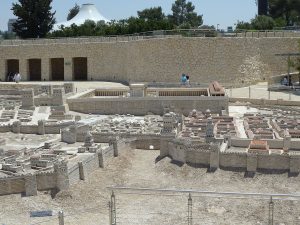Ideology

Model of Ancient Jerusalem, Israel Museum. By Vladislav Bezrukov from Walldorf, Germany – Museum of Israel – Model of the ancient Jerusalem, CC BY 2.0, https://commons.wikimedia.org/w/index.php?curid=41850927
The Dead Sea Scrolls reveal the ideology of the Qumran sect and of other Jews in the Second Temple period, especially how Jews interacted with non-Jews, their view that Jerusalem was the religious epicenter of the Jewish world and how they saw the role of Jerusalem in the End of Days.
The scrolls contain many references to non-Jews and of Jews being the chosen people. These references give us an understanding of the overall history of relations between Jews and non-Jews during this period and also the self-image of the Qumran sect.
Despite the fact that the Qumran sect chose to live outside of Jerusalem, it still affirmed the sanctity and centrality of the holy city, as was true of all kinds of Jews during the Second Temple period. The scrolls talk about three roles for Jerusalem: that of history, the ideal Jerusalem according to Jewish law and the city of the future, in the End of Days.
Primary Sources
Secondary Sources
- Calendar Controversies, Lawrence H. Schiffman, Reclaiming the Dead Sea Scrolls, Jewish Publication Society, Philadelphia 1994.
- Non-Jews in Sectarian Teaching, The Destruction of the Nations, Lawrence H. Schiffman, Reclaiming the Dead Sea Scrolls, Jewish Publication Society, Philadelphia 1994.
- Non-Jews in the Halakhic Letter, Lawrence H. Schiffman, Reclaiming the Dead Sea Scrolls, Jewish Publication Society, Philadelphia 1994.
- Non-Jews in the Sectarian Law of the Zadokite Fragments, Lawrence H. Schiffman, Reclaiming the Dead Sea Scrolls, Jewish Publication Society, Philadelphia 1994.
- Other Laws in the Temple Scroll, Lawrence H. Schiffman, Reclaiming the Dead Sea Scrolls, Jewish Publication Society, Philadelphia 1994.
- Prohibitions Against Idolatry, Lawrence H. Schiffman, Reclaiming the Dead Sea Scrolls, Jewish Publication Society, Philadelphia 1994.
- Proselytes in the Dead Sea Scrolls, Lawrence H. Schiffman, Reclaiming the Dead Sea Scrolls, Jewish Publication Society, Philadelphia 1994.
- The Jerusalem of History, Lawrence H. Schiffman, Reclaiming the Dead Sea Scrolls, Jewish Publication Society, Philadelphia 1994.
- The Jerusalem of Religious Law, Lawrence H. Schiffman, Reclaiming the Dead Sea Scrolls, Jewish Publication Society, Philadelphia 1994.
- The Jerusalem of the End of Days, Lawrence H. Schiffman, Reclaiming the Dead Sea Scrolls, Jewish Publication Society, Philadelphia 1994.
- The Land of Israel and the Temple, Lawrence H. Schiffman, Reclaiming the Dead Sea Scrolls, Jewish Publication Society, Philadelphia 1994.
- The Law of the King, Lawrence H. Schiffman, Reclaiming the Dead Sea Scrolls, Jewish Publication Society, Philadelphia 1994.
- The Revealed and the Hidden, Lawrence H. Schiffman, Reclaiming the Dead Sea Scrolls, Jewish Publication Society, Philadelphia 1994.
- The Study of Qumran Law, Lawrence H. Schiffman, Reclaiming the Dead Sea Scrolls, Jewish Publication Society, Philadelphia 1994.
- Theology of the Temple Scroll, Lawrence H. Schiffman, Reclaiming the Dead Sea Scrolls, Jewish Publication Society, Philadelphia 1994.
- Calendars, Francesca Rochberg-Halton and James C. VanderKam, Anchor Bible Dictionary (ed. David Noel Freedman), Doubleday, New York 1992.
- Legislation Concerning Relations with Non-Jews in the Zadokite Fragments and in Tannaitic Literature, Lawrence H. Schiffman.
- Temple Scroll Revisited- The Gigantic Dimensions of the Visionary Temple in the Temple Scroll, Magen Broshi, Biblical Archaeology Review, Nov-Dec 1987.
- Temple Scroll Revisited- Three New Views, Biblical Archaeology Review, Nov-Dec 1987.
- The Command, According to Philo, Pseudo-Philo, and Josephus, to Annihilate the Seven Nations of Canaan, Louis H. Feldman.
- Temple Scroll, Lawrence H. Schiffman, Anchor Bible Dictionary (ed. David Noel Freedman), Doubleday, New York 1992.
- The Festivals of the Month of Nisan. Reprinted from Yigael Yadin, The Temple Scroll, Israel Exploration Society, Jerusalem 1983.
- The Impurity of the Dead in the Temple Scroll, Lawrence H. Schiffman.
- The King, His Guard, and the Royal Council in the Temple Scroll, Lawrence H. Schiffman, Proceedings of the American Academy for Jewish Research 54 (1987).
- The Scriptural Foundations and Deviations in the Laws of Purity of the Temple Scroll, Jacob Milgrom.
- The Temple Scroll- The Longest and Most Recently Discovered Dead Sea Scroll, Yigael Yadin, Biblical Archaeology Review Sep-Oct 1984.
- Challenge to Sun-Worship Interpretation of Temple Scroll’s Gilded Staircase, Jacob Milgrom, BAR 11-01, Jan-Feb 1985.
- Books in Brief- The Temple Scroll- The Hidden Law of the Dead Sea Sect, Lawrence Schiffman, BAR 11-04, Jul-Aug 1985.
- Intrigue and the Scroll, Hershel Shanks, BAR 13-06, Nov-Dec 1987.
- Is the Temple Scroll a Sixth Book of the Torah—Lost for 2,500 Years? Hartmut Stegemann, BAR 13-06, Nov-Dec 1987.
- Dead Sea Scrolls Spotlight- The Temple Scroll, Magen Broshi, BAR 33-04, Jul-Aug 2007.
- Notes- The Three Temples of 4 Q Florilegium, Daniel R. Schwartz, Revue de Qumran 37 (1979).
- The “Desert Motif” in the Bible and in Qumran Literature, Shemaryahu Talmon, Biblical Motifs, Harvard University Press, Cambridge 1996.
- War Rule (1QM). Reprinted with permission from Philip R. Davies, Anchor Bible Dictionary (ed. David Noel Freedman), Doubleday, New York 1992.
- The Temple Scroll, c. 100 BCE
- Descriptions of the Jerusalem Temple in Josephus and the Temple Scroll, Lawrence H. Schiffman.
- Beatitudes Found Among Dead Sea Scrolls, Benedict T. Viviano, BAR 18-06, Nov-Dec 1992.
What do you want to know?
Ask our AI widget and get answers from this website